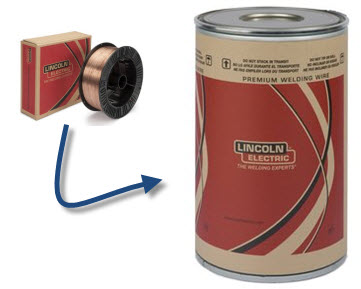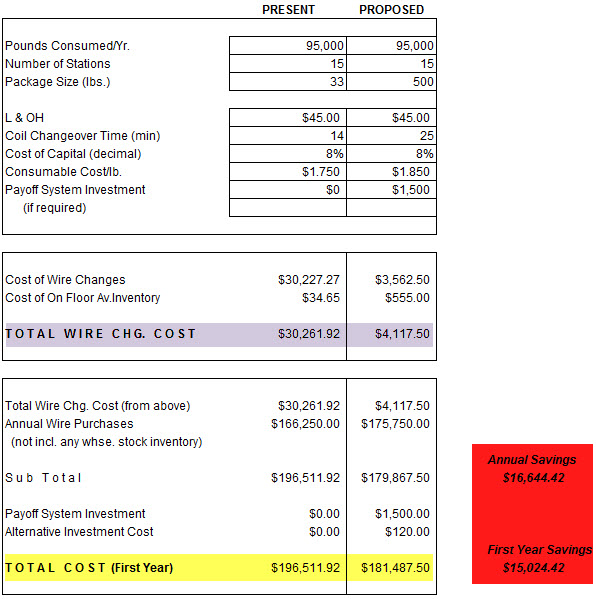A customer recently questioned our advice of going to bulk packaging for his mig wire. He stated that paying an extra $0.10 per pound was the complete opposite of what he wanted to do. We explained how spending a little more per pound would translate into significant savings for his company.
Typically the bigger the package the lower the price. This is why stores like Sam’s Club and Costco appeal to the public. However, when it comes to welding wire this is true only to a point. As you go from a 2# spool all the way up to a 60# coil the price per pound goes down. But when you start looking at a 500# drums the price goes up. This is because winding wire into a drum is a much slower process than spooling into a coil. The wire gets wound with a twist so that it can come out straight. This is because a drum just sits on the floor and is not spun like a spool.
Our customer uses roughly 95,000 pounds of wire per year and has 15 welding stations. He pays $1.75 for .045 wire in a 33# spool. The quote he received from his distributor for the same wire in a 500# drum was $1.85. So his yearly spend on wire would go from $166,250 t0 $175,750. A $9,500 dollar increase!!! We must be crazy to suggest this he though. So after spending a couple of hours on the floor doing some time studies we showed him the following spreadsheet.
As you can see the savings come from fewer changeovers. Changing out a drum takes longer, but you do it less often. The next concern was the cost of having 15 stations carry 500 pounds of wire instead of 33 pounds each. The owner explained that having 500 x 15 = 7,500 pounds of wire on the floor at $1.85/lb would tie up $13,875; while having 33 x 15 = 495 pounds at $1.75/lb only equals $866.25 of in-process inventory. So we asked what his cost of capital was to calculate the true cost of the added inventory. The result? Nothing to worry about, only about $500 a year.
We also included the cost of adding a payoff kit to the drums. Some new bulk packages have this payoff kit integrated into the top lid and this $100 per station would go to zero. We showed him that in year one he would save $15,000 based on his labor & overhead rate of $45.00. At this time the customer is in month three of implementation and the savings are already being realized.
Have you gone from spools to drums or vice versa? Which do you prefer?



I like like the idea of bulk wire and have been trying to justify it but we only use ~15000 lbs of wire/ year so I don’t think the the labor savings in changing rolls is worth the floor space cost of 16 drums. (2 wires * 8 stations)
The usage is a bit low. Depending on what brand of wire you are running you can have other options such as 500-pound and 250-pound drums. This would have more changeovers than the 1,000-lb drums but would cut your in process inventory.
Would the wire inventory capital cost be doubled the numbers given, say $1100 for the drum wire, based on 8% rate?
This will certainly not change the overall picture.
Good analysis overall. Thanks.
Wire inventory should not be ignored, however, at the end of the day the it’s not that many dollars. If you have 10 stations running 500-LB drums you could argue that you have 5,000 of work-in-process inventory and may keep an additional 4 drums as safety stock for a total of 6,000 of wire. If you run spools you’ll typically have a pallet of wire as safety stock which is 3,564 pounds. Plus 330 of in process inventory you are almost at 4,000 pounds. So you are carrying an extra 2,000 pounds of inventory running drums. Paying $1.50 for the wire this would be $3,000 extra dollars tied up in inventory. At 8% that would be an extra $240 per year. With a burden rate of $45/hr this extra costs pays for itself after only only a few days.
We tried drums once but had issues with the wire getting tangled up. I am sure it was because the brand of wire we were using was crap.